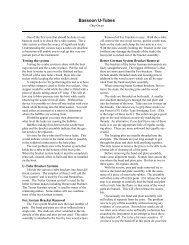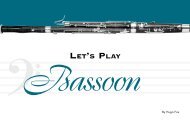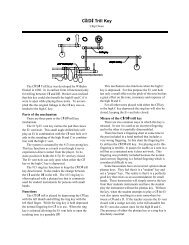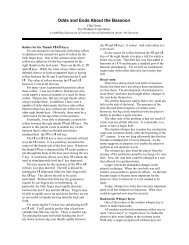The Intermediate Bassoonist - Fox Products
The Intermediate Bassoonist - Fox Products
The Intermediate Bassoonist - Fox Products
Create successful ePaper yourself
Turn your PDF publications into a flip-book with our unique Google optimized e-Paper software.
<strong>The</strong> <strong>Intermediate</strong> <strong>Bassoonist</strong><br />
Bassoon Clinic with Janet Polk<br />
TABLE OF CONTENTS<br />
Introduction……………………………………………………………………… 2<br />
Tone/Sound Production……..…………………………………………………… 3-4<br />
Pitch……………………………………………………………………………… 4-5<br />
Tonguing….……………………………………………………………………… 6-7<br />
Fingers…….……………………………………………………………………… 7<br />
Chamber Music...………………………………………………………………… 7, 11<br />
Tenor Clef...……………………………………………………………………… 7<br />
Vibrato…………………………………………………………………………… 8<br />
Resource Books………...………………………………………………………… 9<br />
Repertoire………………………………………………………………………… 10-11<br />
Bassoon Recordings……………………………………………………………… 12-13<br />
Bassoon Reeds – Quick Fixes…………………………………………………… 14-15<br />
Reed-Making Tools……………………………………………………………… 16<br />
Reed-Making Outline…………………………………………………………… 17<br />
Addresses: Reeds and Tools…………………………………………………….. 18<br />
Buying Bassoons and Bocals…………………………………………………… 19<br />
Addresses: Buying Bassoons…………………………………………………….. 20<br />
Fingering Chart………………………………………………………………… 21-22<br />
Biography……………………………………………………………………… 23<br />
1
<strong>The</strong> <strong>Intermediate</strong> Bassoon Player<br />
Your beginning bassoonist has been playing for several years and has a range of B-Flat<br />
below the staff in bass clef to at least G above the staff in bass clef.<br />
If all is going well, the student will be playing with a full sound, have a good sense of<br />
pitch, and be able to tongue and finger passages with an ever increasing amount of<br />
facility. If this is the case, the next steps are to increase the range up a fourth and to<br />
begin the use of vibrato if it is not already in place (see section on developing a vibrato).<br />
Chances are that one or more areas may need some help. This guide will attempt to<br />
identify the potential problems and suggest some solutions.<br />
2
Tone/Sound Production<br />
Problems: tone may be small or weak, unfocused, too tight, too “buzzy”<br />
Solutions:<br />
1. Embouchure<br />
a. <strong>The</strong> lips should be around the reed. Say the words such as spoon or loon<br />
or prune with lips in exaggerated “o” position. <strong>The</strong> outside of the lips are<br />
firm but the inside of the lips have flexibility (“spongy”).<br />
b. <strong>The</strong> lips should be showing a portion of red when the embouchure is<br />
formed. <strong>The</strong> lips do not roll totally over the lips. <strong>The</strong> lips will be<br />
supported by the teeth but minimally.<br />
c. <strong>The</strong> teeth are pulled apart as far as is comfortable. <strong>The</strong> tongue is relaxed<br />
and on the bottom of the mouth.<br />
d. <strong>The</strong> reed goes into the mouth almost to the first wire. If not enough reed<br />
is in the mouth, a thin buzzy tone is produced.<br />
e. Find the crow point on the reed—this is a multiphonic rasp with highs,<br />
lows, and middles in the sound. This is perhaps the most important<br />
element to achieve. It is through allowing the reed to vibrate at its<br />
maximum that a full, focused, flexible tone is produced.<br />
f. Lips are looser for low notes, firmer for high notes.<br />
2. Position of the bassoon/posture<br />
a. Seat strap goes across the front of the chair<br />
b. <strong>The</strong> bassoon goes across the body<br />
c. <strong>The</strong> head, neck and spine are aligned and shoulders and fingers relaxed.<br />
Feet flat on floor.<br />
d. Wrists should be straight on both arms when playing<br />
3. Breathing/Blowing<br />
a. Since the opening to the reed is small, many students do not use enough<br />
support from the vertical abdominal muscles to produce a full sound.<br />
Have them give a bit more “oomph.” This is especially true to produce<br />
the higher notes—the higher the note, the more support (and vice versa)<br />
b. Air is separate from support. For bassoon for most passages, the lungs<br />
need to be filled only a third of the way from the bottom. <strong>The</strong> remaining<br />
space in the lungs creates flexibility for pitch adjustment and vibrato.<br />
c. Shoulders and chest remain down and relaxed.<br />
4. Reeds<br />
At this stage of development, students should be using cane reeds. However, that<br />
presents some interesting challenges as one needs to find a source for reliable<br />
reeds. This means reeds that play easily, have a good crow and have a stable<br />
pitch center. <strong>The</strong> best source for cane reeds is a local professional bassoonist. If<br />
there is a music school or conservatory nearby, an advanced student would<br />
3
Pitch<br />
probably be eager to make a few bucks. If this is not possible, the listing at the<br />
end of this booklet give addresses for reliable sources for reeds. It may take a bit<br />
of trial and error for the student to find a source that is perfect for him/her.<br />
5. Bocals<br />
a. A good bocal can make an inferior instrument sound much better and a<br />
bad bocal can make the best instrument sound terrible. Check for dents or<br />
cracks. <strong>The</strong>se should be repaired as even small imperfections can<br />
sometimes lead to big tone and pitch problems. If things look o.k. but if<br />
you are unsure, have a professional try it out. (see list at end for purchase<br />
of new bocals).<br />
b. Bocals should be cleaned every 2 weeks or so with warm water and once a<br />
month with water and pipe cleaners or bocal swab or bocal brush.<br />
6. Bassoons<br />
If all else fails, an assessment of the bassoon is in order. Have a professional play<br />
it and give an opinion of the instrument and its capabilities. (see lists at end for<br />
bassoon brands and where to purchase bassoons)<br />
Problems: Pitch is constantly sharp or constantly flat. Pitch problems occur on certain<br />
notes. Pitch is all over the map!<br />
Solutions: pitch is constantly sharp<br />
1. Bocals<br />
a. Bocals come in sizes 0 to 4 with the most common being 1, 2, and 3. <strong>The</strong><br />
smaller the number, the shorter the bocal and sharper in pitch. <strong>The</strong> larger<br />
the number, the longer the bocal and flatter in pitch. Try a longer bocal.<br />
<strong>The</strong> bocal goes all the way in and should not be pulled out or pushed in to<br />
adjust pitch. All it does is throw off the scale.<br />
2. Embouchure/placement of tongue<br />
a. Lips should be away from teeth<br />
b. Teeth pulled apart as far as is comfortable<br />
c. TONGUE SHOULD BE RELAXED AND AT BOTTOM OF MOUTH.<br />
THE BACK OF THE ORAL CAVITY IS AS OPEN AS POSSIBLE.<br />
d. Lips remain firmly in a circle around the reed.<br />
3. Reeds<br />
Reeds have different pitch centers. Have student work with several to see if this<br />
makes a difference.<br />
4. Work with tuner and play solos with an in-tune piano.<br />
4
5. Have the bassoon evaluated<br />
Solutions: Pitch is constantly flat<br />
1. Bocals<br />
Try a shorter one<br />
2. Embouchure<br />
Lips should be firmly around reed so that no air is escaping and so enough<br />
support is given.<br />
3. Air<br />
Firm support should be given from the vertical abdominal muscles. More<br />
“oomph”!<br />
4. Reeds<br />
Try several to see which ones may bring up the pitch.<br />
5. Work with a tuner<br />
6. Have the bassoon evaluated for quality but also for potential repair problems.<br />
Leaks can account for a lowered pitch.<br />
Solutions: Pitch problems occur on certain notes<br />
1. Inherent nature of the instrument<br />
Notes on the bassoon come from the factory with some deliberately tuned flat and<br />
some sharp to balance overall acoustics and tone quality. As a general rule, the<br />
worst is fourth space G. Adding a key (see fingering chart) may help but mostly<br />
it is a matter of hearing it and bringing it down by control of the embouchure and<br />
air column. Third space E-flat can be very sharp. This is usually a reed problem<br />
but there are some alternate fingerings (see chart) that will stabilize this as well.<br />
2. Fingerings<br />
Get a good, reliable chart and make sure that the student is using correct<br />
fingering.<br />
3. Bassoon/Bocal<br />
Another bocal may help problem notes. Have bassoon checked by professional<br />
and repair person.<br />
Solutions: Pitch is all over the map!<br />
All of the above suggestions should be tried first. If none of the above help, it is<br />
time to work on the student’s sense of pitch through singing pitches, playing intervals<br />
with another instrument, working with a tuner and/or playing an in-tune piano. It is a<br />
life-long struggle for all bassoonists, professional and amateur.<br />
5
Tonguing<br />
Problems: Tongue is not very fast.<br />
Solutions:<br />
1. Relax the tongue. Practice letting it fall to bottom of the mouth.<br />
2. Start notes with tongue lightly placed on reed. Blow, then release the tongue from<br />
the reed.<br />
3. “Tip to tip.” <strong>The</strong> tip (or as close as possible) of the tongue should touch directly<br />
the tip or opening of the reed. Not on the bottom of the reed or on the top. This<br />
“tip to tip” provides a clear articulation and can achieve the lightest tongue.<br />
4. <strong>The</strong> lightest possible touch on the reed is the goal. A good way for students to<br />
achieve this is to use only the reed. Begin by holding the reed and tonguing rapid<br />
notes. <strong>The</strong>n remove the hand from the reed. <strong>The</strong> object is to tongue the reed so<br />
that it doesn’t fly out of the mouth and has little or no motion when tongued. Put<br />
back on bassoon and try with the same technique.<br />
5. Use plenty of air. <strong>The</strong> secret to fast tonguing is air. <strong>The</strong> tongue should just ride<br />
the supported air column.<br />
6. Try a lighter syllable. Instead of “Too” try “doo” or even “loo” if the tongue is<br />
very heavy.<br />
7. Use just the very front of the tongue. Keep the back of the tongue still.<br />
8. Practice tonguing exercises such as the following. <strong>The</strong> tongue is set of muscles<br />
that need to be strengthened.<br />
a. Do on reed only first and then on one note on bassoon<br />
b. Set starting metronome tempo of = 60 or lower<br />
c. Increase metronome gradually<br />
d. Keep a chart of progress from day-to-day<br />
9. Start work on double-tonguing. Some people just do not have a fast single tongue<br />
and never will. <strong>The</strong> following exercises should be done on the reed first and then<br />
on the bassoon.<br />
a. Use “too-koo” or “doo-goo”<br />
> ><br />
<br />
too koo too koo<br />
b. Accent the “koo” to achieve evenness of articulation<br />
6
Fingers<br />
c. Keep the air stream constant<br />
d. Use metronome—gradually speed up<br />
e. Use “William Tell Overture” theme to practice short, quick, bursts.<br />
Problem: fingers are just not moving quickly<br />
Solutions:<br />
1. Make sure that finger pressure on keys and on holes is as light as possible. Wrists<br />
should be straight. Fingers slightly curved.<br />
2. Determine if it is a problem only with tongue. Practice scales and etudes slowly<br />
listening for the timing of the start of the tongue and movement of the fingers.<br />
Gradually speed up.<br />
3. If fingers are not moving well in general, work on scales SLOWLY, aiming for<br />
fingers that move evenly and smoothly from one note to the next. Slurring all<br />
notes will eliminate any problems with the tongue. Make sure all fingers that<br />
need to move to obtain a certain note do so at precisely the same time. Use of the<br />
metronome is important as this will keep track for the student how she/he is<br />
doing. Move the metronome up gradually. Set speed goals and keep a daily<br />
record.<br />
4. Work on etudes especially those that deal with finer patterns (see Etude list.<br />
Slama and Kopprasch especially helpful).<br />
Chamber Music<br />
One of the most important things you can do for your intermediate bassoonist is to place<br />
him/her in a chamber ensemble. <strong>The</strong> bassoonist can really shine in a small group. For<br />
one thing, the bassoon can be heard! For those students only in band, this can be a<br />
problem. If the student perceives that he/she is not being heard, the incentive to improve<br />
the above problems is not there. When the student becomes one of three or four or five,<br />
suddenly there is a reason to get better in a hurry! (see repertoire list for chamber music<br />
listings).<br />
Tenor Clef<br />
Although they will try to avoid it at all costs, students at this level need to know tenor<br />
clef. <strong>The</strong> Rubank methods (Elementary and <strong>Intermediate</strong>) have several pages that will<br />
ease a student into this territory.<br />
7
Vibrato<br />
Some students just naturally begin a vibrato. This is especially true for those who sing.<br />
For those that don’t produce vibrato on their own need, help is needed to train the<br />
muscles. <strong>The</strong> following are some suggested ways to get things going. <strong>The</strong> process from<br />
start to finish may take as little as 2 months or as much as 2 years. <strong>The</strong> object is to have<br />
patience and to do a little bit of training every day.<br />
a. Begin note. Relax abdominal muscles so that pitch sags almost a half<br />
step. Return to original note by firming muscles.<br />
b. Practice at any slow tempo until confident of the ability to drop the pitch.<br />
c. Set Metronome at = 50 or below. Do above exercises with metronome.<br />
d. Gradually increase tempo<br />
e. As muscles become stronger, pitch will go above the pitch as well as<br />
below.<br />
f. Final goal at = 144<br />
8
BEYOND BASICS!<br />
RESOURCE BOOKS<br />
<strong>Fox</strong>, Hugo. Let’s Play Bassoon.<br />
<strong>Fox</strong> <strong>Products</strong> Corp., South Whitley, Indiana<br />
Popkin, Mark, and Glickman, Loren. Bassoon Reed Making.<br />
<strong>The</strong> Instrumentalist Publishing Co., Northfield, Illinois, 1987<br />
Pence, Homer. Teacher’s Guide to the Bassoon.<br />
Selmer, Inc., Elkhart, Indiana, 1963<br />
Snitkin, Harvey R. Practicing for Young Musicians.<br />
HMS Publications, Inc., Niantic, Conn., 1983<br />
Spencer, William. <strong>The</strong> Art of Bassoon Playing.<br />
Summy-Bichard Co., Evanston, Illinois, 1969<br />
Weait, Christopher. Bassoon Reed-making: A Basic Technique.<br />
McGinnis & Marx Music Publishers, New York, 1970<br />
9
Etude Books:<br />
REPERTOIRE FOR THE INTERMEDIATE LEVEL<br />
Voxman <strong>Intermediate</strong> and Advanced Method, vol.1 Rubank<br />
Standard etude books. Provides good, solid foundation. Has recognizable pieces so<br />
appeals to some students more than Weissenborn (see listing below).<br />
Weissenborn Practical Method Fischer or Cundy-Bettoney<br />
<strong>The</strong> standard since the 1800’s. <strong>The</strong> front of the book is for beginners through<br />
intermediates. Back of the book (Advanced Studies) is for intermediate and up.<br />
Slama 66 Studies International<br />
Studies in all keys. Starts with no sharps or flats, goes to one flat and works through all<br />
the keys. Good practice for finger patterns.<br />
Kopprasch 60 Studies, Vol. 1 International<br />
Technical etudes good for learning patterns<br />
Ozi 42 Caprices International<br />
Mozart era etudes about a half page in length. Charming.<br />
Milde 25 Studies in Scales and Chords International<br />
For the more advanced intermediate. Has extended range.<br />
In order of difficulty:<br />
SOLOS<br />
Duport Romanze Spratt<br />
Senaille Allegro Spiritoso Andraud<br />
Cohen Danse Grotesque Belwin<br />
Rathaus Polichinelle Belwin<br />
Schoenbach Solos for the Bassoon Player Schirmer<br />
Starkadomsky Four Pieces International<br />
10
Mozart Two Sonatas Belwin<br />
Eccles Sonata in G Minor International<br />
Hindemith Sonate Schott<br />
(First movement for intermediate level)<br />
Mozart Concerto in B flat K191 International<br />
(2 nd and 3 rd movements for intermediate level)<br />
Telemann Sonata in F Minor International<br />
Vivaldi Sonata in A Minor International<br />
Vivaldi Ten Bassoon Concertos Schirmer<br />
(edited by Schoenbach)<br />
Gliere Impromtu International<br />
Humoresque International<br />
Any Baroque Trio Sonatas<br />
CHAMBER MUSIC<br />
Chamber Music for Three Woodwinds (fl., cl., bsn.) Rubank<br />
Ensemble Repertoire for Woodwind Quintet Rubank<br />
Andraud 22 Woodwind Quintets Southern<br />
Vivaldi Concerto in G Minor for fl. ob. bsn. Musica Rara<br />
Vivaldi Sonata a due for fl. bsn. and basso continuo Peters<br />
Zachow Trio for fl. bsn. and basso continuo Belwin<br />
Mozart Divertimenti for 2 cls. and bsn. various publishers<br />
or ob. cl. bsn.<br />
11
BASSOON RECORDINGS<br />
Stefano Canuti Stradivarius Bassoon Images<br />
Fone Fantasie Di Bravura<br />
Crystal 25 th Anniversary<br />
International Double Reed<br />
Society<br />
Bernard Garfield Columbia Mozart – <strong>The</strong> Four Concertos<br />
for WW’s<br />
Jurgen Gode Antes Edition <strong>The</strong> Bassoon<br />
Paul Hanson (jazz bassoon) Tonga Oaktown Irawo<br />
Funky Cubonics<br />
Laslo Hara, Jr. Hungaraton <strong>The</strong> Classical and Baroque<br />
Bassoon<br />
Judith LeClair Sony <strong>The</strong> Five Sacred Trees<br />
John Miller Pro-Arte Concertos for<br />
Cambridge Bassoon<br />
Frank Morelli Deutsche Grammophon Mozart Bassoon Concerto<br />
Leonard Sharrow Crystal Leonard Sharrow Plays<br />
Works for Bsn.<br />
Robert Thompson Chandos Records Vivaldi – 4 Bassoon<br />
Concertos<br />
Klaus Thuneman Philips Vivaldi – 6 Bassoon<br />
Concertos<br />
Milan Turkovic Teldec Mozart – Concertos for<br />
Winds<br />
Koch United Sounds of Bassoons<br />
Kim Walker Edgetone Classics Mozart Concertos<br />
Christopher Weait d’note Telemann for bsn.<br />
Lyrichord Four Centuries of Music for<br />
Bsn.<br />
12
VIDEO<br />
Janet Polk Warner Bros. Pub. Belwin 21 st Century Band<br />
Method, vol. 1<br />
13
BASSOON REEDS<br />
<strong>The</strong> condensed guide to quick fixes.<br />
For those music educators who feel comfortable or interested in adjusting purchased<br />
reeds, the following is a guide to the basic tools needed and to trouble-shooting the most<br />
common problems.<br />
BASIC TOOLS NEEDED:<br />
1. mandrel or the equivalent for holding the reed<br />
2. reamer or round file for taking material from the inside of the reed for better<br />
fit on bocal<br />
3. plaque or guitar pick for placement between blades of the reed<br />
4. reed knife or jackknife<br />
5. needle nose pliers<br />
6. scissors<br />
7. #22 soft brass wire or equivalent for a broken wire<br />
THE MOST COMMON PROBLEMS AND THEIR SOLUTIONS<br />
<strong>The</strong> reed should be wet for all reed adjustments<br />
1. <strong>The</strong> reed is too hard to blow.<br />
a. Check tip opening. This should be 1/16 th of an inch.<br />
b. If too open, close at first wire with pliers.<br />
c. If too open, open at first wire with pliers.<br />
d. If tip opening is o.k., put reed on mandrel, put plaque between blades<br />
and take off cane on both sides of the reed with a knife or sandpaper.<br />
2. Third space E sags/goes flat<br />
a. Clip the smallest amount possible off the tip (which makes the reed<br />
slightly shorter). Test and clip until the E is stable.<br />
3. Third space E-flat is sharp/unstable.<br />
a. Put reed on mandrel and plaque between blades. Scrape the channels<br />
(see diagram next page).<br />
4. Low notes are hard to get out<br />
a. Reed on mandrel, plaque between blades. Scrape tip and back with<br />
knife (see diagram next page).<br />
14
BASSOON REED-MAKING TOOLS<br />
<strong>The</strong> following list is for a student or teacher who might be interested in pursuing reed<br />
making.<br />
ITEMS THAT MAY BE OBTAINED FROM LOCAL STORES<br />
6 inch ruler<br />
jackknife<br />
emery boards or flat file<br />
exacto knife or scalpel<br />
needle nose pliers<br />
diagonal clippers<br />
wooden drawer knob<br />
guitar picks<br />
wet/dry sandpaper 240 & 400<br />
Duco cement<br />
crochet thread or button & carpet thread<br />
sharp scissors<br />
single-edged razor blades<br />
nail set<br />
round file<br />
paraffin wax or a candle<br />
SPECIALIZED TOOLS TO ORDER<br />
mandrel (replaces nail set)<br />
reamer (replaces round file)<br />
plaque (replaces guitar pick)<br />
reed knife (replaces jackknife)<br />
drying rack<br />
cutting block (replaces wooden drawer knob)<br />
#22 soft brass wire<br />
gouged, shaped, and profiled bassoon cane<br />
FOR BASSOON REPAIR AND MAINTENANCE<br />
screwdriver<br />
cloth tape<br />
moleskin<br />
spring hook or crochet hook<br />
pipe cleaners<br />
16
Reed-making Outline—Janet Polk method<br />
1. soak gouged, shaped, and profiled cane for 3 hours or more<br />
2. bevel underside edges with sandpaper<br />
3. measure center and fold<br />
4. put 1 st wire on at 1 inch from butt end, 2 nd wire 11/16ths<br />
5. make five to seven scores in butt end with razor blade<br />
6. make more scores with exacto knife or razor blade from 2 nd wire down between<br />
the five to seven scores<br />
7. 3 rd wire on at 3/16ths inch from butt end<br />
8. form with mandrel<br />
9. tighten wires, DRY OVERNIGHT<br />
10. re-tighten wires, pull 3 rd wire over to side, clip, push down<br />
11. Duco reed from 2 nd wire down<br />
12. wrap with string<br />
13. Duco string, LET DRY AT LEAST 24 HOURS<br />
14. ream reed to fit on bocal 8 mm<br />
15. clip 1 st and 2 nd wires to 4 twists, push down<br />
16. soak reed for about 3 minutes<br />
17. measure from butt end to tip 2 and 3/16ths inches<br />
18. clip with scissors<br />
19. open reed with pliers so that tip is open 1/16 th inch<br />
20. scrape reed (see “Starting a student -- ” or “<strong>The</strong> <strong>Intermediate</strong> <strong>Bassoonist</strong>” for<br />
guide)<br />
17
BASSOON REEDS (r) and TOOLS (t)<br />
<strong>Fox</strong> <strong>Products</strong> (r & t) Phone: (260) 723-4888<br />
6110 S. SR 5, P.O. Box 347<br />
South Whitley, IN 46787<br />
Charles Double Reed Co. (r & t) Phone: 1-800-REEDTIP (orders only)<br />
30 Pleasant St., P.O. Box 2610 (603) 447-1110<br />
Conway, NH 03818-2610<br />
Vigder’s Bassoon Supplies (r) Phone: (310) 231-0220<br />
11746 Goshen Ave., Apt. 3<br />
Los Angeles, CA 90049-6113<br />
Jones Double-Reed <strong>Products</strong> (r & t) Phone: (509) 747-1224<br />
P.O. Box 3888<br />
Spokane, WA 99220-3888<br />
Mark Chudnow Woodwinds (r & t) Phone: 1-800-780-4340<br />
5 Manchester Court (707) 254-7388<br />
Napa, CA 94558<br />
Forrest’s (r & t) Phone: 1-800-322-6263<br />
1849 Univ. Ave.<br />
Berkeley, CA 94703<br />
Mark Popkin (t) Phone: (336) 725-5681<br />
740 Arbor Rd.<br />
Winston-Salem, NC 27104-2210<br />
Jack Spratt Woodwind Shop (t) Phone: (203) 637-1176<br />
11 Park Ave.<br />
P.O. Box 277<br />
Old Greenwich, CT 06870<br />
Frederic H. Weiner, Musical Instruments Sales and Service (t)<br />
216 East Jericho Turnpike Phone: 1-800-622-CORK (orders only)<br />
Mineola, NY 11501 (516) 747-5004<br />
Arundo Reeds and Cane (r)<br />
18082 NW Dixie Mt. Rd.<br />
Hillsboro, OR 97124<br />
revised 1/99<br />
18
Bassoon Brands<br />
BASSOONS AND BOCALS<br />
This is a list of the most common brands of bassoons that you will encounter.<br />
<strong>Fox</strong>/Renard<br />
Heckel<br />
Puchner<br />
Schreiber<br />
Moenning<br />
Polisi<br />
Sonora/Adler<br />
Yamaha<br />
Conn<br />
Bundy<br />
Linton<br />
To buy a new bassoon for a school system, the most reliable and consistent are the<br />
<strong>Fox</strong>/Renard. Even when new, other brands can run the gamut from good to bad. Have<br />
them checked out by a professional.<br />
Used bassoons can also be wonderful instruments or real dogs. It is especially important<br />
to have a professional help out on the purchase.<br />
Bocals<br />
Bocals can make or break a bassoon. <strong>The</strong> bocal that is being considered for purchase<br />
should be played on the instrument for which it is intended. Criteria are:<br />
1. General level of pitch and ability to play all notes in tune with a minimum of<br />
adjustment throughout range.<br />
2. Evenness of tone throughout range<br />
3. Full sound<br />
4. Ability to play loud and soft<br />
5. Pleasing quality<br />
Bocals can be purchased from the same places as bassoons. Heckel bocals and<br />
<strong>Fox</strong>/Renard bocals are the best quality.<br />
19
BUYING BASSOONS<br />
<strong>The</strong> Woodwind/<strong>The</strong> Brasswind Phone: 1-800-348-5003<br />
19880 State Line Rd.<br />
South Bend, IN 46637<br />
Washington Music Center Phone: (301) 946-8808<br />
11151 Viers Mill Rd.<br />
Wheaton, MD 20902<br />
Wichita Band Instrument Co. Phone: 1-800-835-3006<br />
2525 East Douglas<br />
Wichita, KS 67211<br />
Frederic Weiner, WW Musical Inst. Phone: (516) 747-5004 or<br />
216 East Jericho Turnpike 1-800-622-CORK<br />
Mineola, NY 11501<br />
Forrest’s Phone: 1-800-322-6263<br />
1849 Univ. Ave.<br />
Berkeley, CA 94703<br />
American Bassoon Co., Inc. Phone: 1-800-ITS-A601<br />
8642 Tower Dr.<br />
Laurel, MD 20723<br />
Rent to Own:<br />
Louise Goni Phone: (781) 862-6323<br />
57 Paul Revere Rd.<br />
Lexington, MA 02173<br />
To Purchase Music:<br />
Eble Music Co. Phone: (319) 338-0313<br />
P.O. Box 2570<br />
Iowa City, IA 52244<br />
Gail Warnaar Double Reed Shop Phone: (802) 633-4014<br />
P.O. Box 150<br />
Barnet, VT 05821<br />
20
Janet Polk, bassoon, earned her Bachelor’s degree in music education at the University of<br />
Massachusetts/Amherst and her Master’s in music history at the University of New<br />
Hampshire. After graduation from UMass, she taught K-6 classroom music in the<br />
Montague, Massachusetts public school system for five years. Currently, she is principal<br />
bassoonist of Portland (Maine) Symphony and Vermont Symphony. She has also<br />
performed with the Springfield (Massachusetts) Symphony, New Hampshire Symphony,<br />
New Hampshire Music Festival, and Indian Hill Symphony and traveled to Honduras<br />
through the Partners of the Americas. As a member of the Block Ensemble, she has won<br />
prizes in the International Concert Artists Guild competition and John Knowles Paine<br />
competition and performed at the prestigious Round Top Festival in Texas.<br />
In addition to her performing career, Ms. Polk teaches bassoon at the University of New<br />
Hampshire, Dartmouth College, Concord Community Music School, and St. Paul’s<br />
school. As a clinician for the <strong>Fox</strong> <strong>Products</strong> Corporation, she presents workshops for<br />
music educators throughout the country. She has just completed an instructional video<br />
for beginning bassoonists for the Warner Brothers publications.<br />
23








